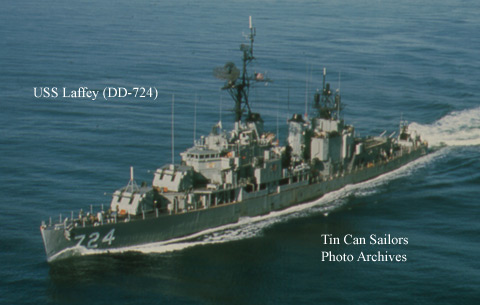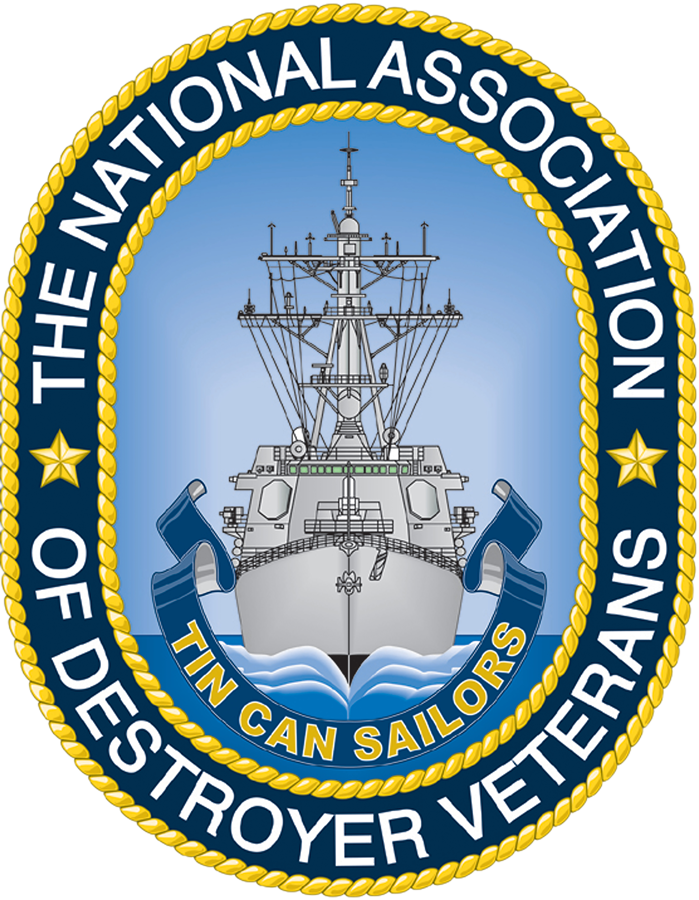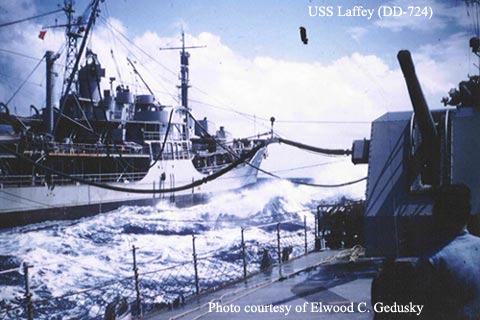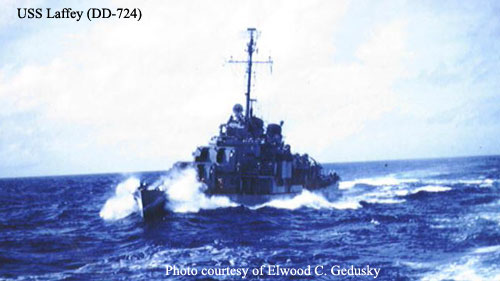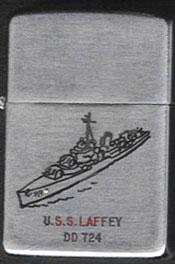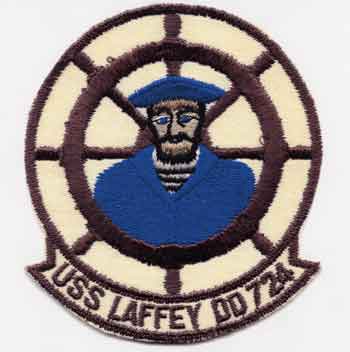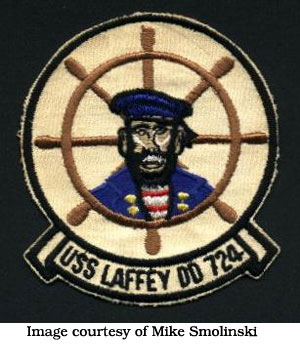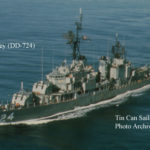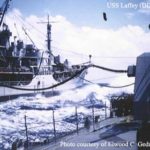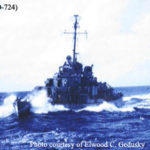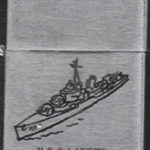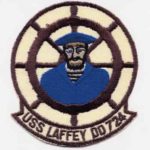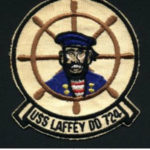USS LAFFEY DD-724 Ship History
Dictionary of American Naval Fighting Ships, May 2020
The second Laffey (DD-724) was laid down on 28 June 1943 at Bath, Maine, by Bath Iron Works Corp.; launched on 21 November 1943; sponsored by Miss Beatrice F. Laffey, daughter of Seaman Laffey; and commissioned on 8 February 1944, Cmdr. Frederick J. Becton in command.
Upon completion of underway training, Laffey visited Washington [D.C.] Navy Yard for a day and departed on 28 February 1944, arriving at Bermuda on 4 March. She returned briefly to Norfolk where she served as school ship, then headed for New York to join the screen of a convoy for England on 14 May. Refueling at Greenock, Scotland, the ship continued on to Plymouth, England, arriving on 27 May.
Laffey immediately prepared for the invasion of France. On 3 June 1944 she headed for the Normandy beaches escorting tugs, landing craft, and two Dutch gunboats. The group arrived in the assault area, off Utah Beach, Bale de la Siene, France, at dawn on D-Day, 6 June. On the 6th and 7th, Laffey screened to seaward; and on the 8th and 9th, she bombarded gun emplacements with good results. Leaving the screen temporarily, the ship raced to Plymouth to replenish and returned to the coast of Normandy the next day. On 12 June, Laffey pursued enemy E-boats which had torpedoed destroyer Nelson (DD-623), and broke up their tight formation and prevented further attacks.
Screening duties completed, the ship returned to England, arriving at Portsmouth on 22 June 1944 where she tied up alongside the battleship Nevada (BB-36) . On 25 June she got underway with the battleship to join Bombardment Group 2 shelling the formidable defenses at Cherbourg, France. Upon reaching the bombardment area, the group was taken under fire by shore batteries; and destroyers Barton (DD-722) and O’Brien (DD-725) were hit. Laffey was hit above the waterline by a richocheting shell that failed to explode and did little damage.
Late that day the bombardment group retired and headed for England, arriving at Belfast on 1 July 1944. She sailed with Destroyer Division 119 three days later for home, arriving at Boston on 9 July. After a month of overhaul, the destroyer got underway to test her newly installed electronic equipment. Two weeks later, Laffey set course for Norfolk, arriving on 25 August.
Next day the destroyer departed for Hawaii via the Panama Canal and San Diego, Calif., arriving at Pearl Harbor on 18 September. On 23 October after extensive training, Laffey departed for the war zone, proceeding via Eniwetok, mooring at Ulithi 5 November. The same day she joined the screen of Task Force 38, then conducting airstrikes against enemy shipping, aircraft, and airfields in the Philippines. On 11 November the destroyer spotted a parachute, left the screen, and rescued a badly wounded Japanese pilot who was transferred to carrier Enterprise (CV-6) during refueling operations the next day. Laffey returned to Ulithi on 22 November and on the 27th set course for Leyte Gulf with ships of Destroyer Squadron 60. Operating with the Seventh Fleet, the destroyer screened the big ships against submarine and air attacks, covered the landings at Ormoc Bay on 7 December, silenced a shore battery, and shelled enemy troop concentrations.
After a short upkeep in San Pedro Bay, Leyte, 8 December 1944, Laffey, with ships of Close Support Group 77.3 departed on 12 December for Mindoro, where she supported the landings on 15 December. After the beachhead had been established, Laffey escorted empty landing craft back to Leyte, arriving at San Pedro Bay on 17 December. Ten days later Laffey joined Task Group 77.3 for patrol duty off Mindoro.
After returning briefly to San Pedro Bay, she joined the Seventh Fleet, and, during the month of January 1945, screened amphibious ships landing troops in the Lingayen Gulf area of Luzon. Retiring to the Caroline Islands, the destroyer arrived at Ulithi on 27 January. During February, the ship supported Task Force 58, conducting diversionary airstrikes at Tokyo and direct air support of marines landing on Iwo Jima. Late in February, Laffey carried vital intelligence information to Commander in Chief, Pacific Fleet, at Guam, arriving on 1 March.
The next day, the destroyer arrived at Ulithi for intensive training with battleships of Task Force 54. On 21 March 1945, she sortied with the task force for the Okinawa invasion. Laffey helped capture Kerama Retto, bombarded shore establishments, harassed the enemy with fire at night, and screened heavy units. Assigned to a radar picket station 30 miles north of Okinawa, Laffey arrived on 14 April and almost immediately joined in repulsing an air attack which cost the enemy 13 airplanes.
The next day, the enemy launched another severe air attack with some 50 planes. About half of the Japanese raiders broke through the screen to Laffey. The game destroyer splashed nine and friendly aircraft destroyed others. But, when the attack was over, the ship had been badly damaged by four bombs and five kamikaze hits. The gallant destroyer suffered 103 casualties: 32 dead and 71 wounded.
Laffey was taken under tow and anchored off Okinawa on 17 April 1945. Temporary repairs were rushed and the destroyer sailed for Saipan arriving on 27 April. Four days later, she got underway for the west coast via Eniwetok and Hawaii arriving at Seattle on 24 May. She entered dry dock at Todd Shipyard Corp. for repairs that lasted until 6 September, then she sailed for San Diego, arriving on 9 September.
Two days later the ship got underway for exercises but collided with the submarine chaser PC-815 in a thick fog. She rescued all but one of the PC’s crew before returning to San Diego for repairs.
On 5 October 1945 she sailed for Pearl Harbor, arriving on 11 October. Laffey operated in Hawaiian waters until 21 May 1946 when she participated in the atomic bomb tests at Bikini, actively engaged in collecting scientific data. Upon completion of the tests she sailed for the west coast via Pearl Harbor arriving at San Diego on 22 August for operations along the west coast.
In February 1947 Laffey made a cruise to Guam and Kwajalein and returned to Pearl Harbor on 11 March. The ship operated in Hawaiian waters until departing for Australia on 1 May. She returned to San Diego on 17 June, decommissioned on 30 June 1947, and entered the Pacific Reserve Fleet.
Laffey was recommissioned on 26 January 1951, Cmdr. Charles Holovak in command. After shakedown out of San Diego, the destroyer headed for the east coast arriving at Norfolk in February for overhaul followed by refresher training at Guantanamo Bay, Cuba. In mid-January 1952, she sailed for Korea, arriving in March. The ship operated with Task Force 77 screening carriers Antietam (CV-36) and Valley Forge (CV-45) until May, when Laffey joined a bombardment and blockade group in Wonson Harbor engaging several enemy shore batteries. After brief refit at Yokosuka on 30 May, the ship returned to Korea where it rejoined Task Force 77. On 22 June Laffey sailed for the east coast, transiting the Suez Canal and arriving Norfolk on 19 August.
The destroyer operated in the Caribbean with a hunter-kilIer group until February 1954, departing on a world cruise which included a tour off Korea until 29 June. Laffey departed the Far East bound for the east coast via the Suez Canal arriving Norfolk on 25 August 1954. Operating out of Norfolk, the destroyer participated in fleet exercises and plane guard duties, and on 7 October rescued four passengers from Able Lady, a schooner which had sunk in a storm off the Virginia Capes.
During the first part of 1955, Laffey participated in extensive antisubmarine exercises, visiting Halifax, Nova Scotia, New York City, Miami, and ports in the Caribbean. During 1956 she operated with ASW carriers in Floridian and Caribbean waters.
On 7 November 1956 the destroyer departed Norfolk and headed for the Mediterranean at the height of the Suez crisis. Upon arrival she joined the Sixth Fleet which was patrolling the Israeli-Egyptian border showing the U.S. flag and expressing our interest in the peaceful outcome of the crisis. When international tensions eased, Laffey returned to Norfolk on 20 February 1957, and resumed operations along the Atlantic coast departing 3 September for NATO operations off Scotland. She then headed for the Mediterranean and rejoined the Sixth Fleet. Laffey returned to Norfolk on 22 December 1957. In June 1958 she made a cruise to the Caribbean for a major exercise.
Returning to Norfolk, the next month she resumed regular operations until 7 August 1959 when she deployed with Destroyer Squadron 32 for the Mediterranean. Laffey transited the Suez Canal on 14 December, stopped at Massawa, Eritrea, and continued on the Aramco loading port of Ras Tanura, Saudi Arabia, where she spent Christmas. The destroyer operated in the Persian Gulf until late January when it transited the Suez Canal and headed for home, arriving Norfolk on 26 February 1960. Laffey then operated out of Norfolk, making a Caribbean cruise; and, in mid-August, the ship participated in a large naval NATO exercise. In October the ship visited Antwerp, Belgium, returning Norfolk on 20 October, but headed back to the Mediterranean in January 1961.
While there she assisted Dara, a British freighter in distress. The destroyer sailed for home in mid-August and arrived at Norfolk on the 28th. Laffey set out in September on a vigorous underway training program and continued this training until February 1963, when she assumed the duties of service ship for the Norfolk Test and Evaluation Detachment. Between October 1963 and June 1964 Laffey operated with a hunter-killer group along the eastern seaboard and on 12 June made a midshipman cruise to the Mediterranean, arriving in Palma, Majorca on 23 June. Two days later the task group departed for a surveillance mission observing Soviet naval forces training in the Mediterranean. Laffey visited Mediterranean ports of Naples, Italy; Theoule, France; Rota and Valencia, Spain, returning to Norfolk 3 September. Laffey continued to make regular Mediterranean cruises with the Sixth Fleet, and participated in numerous operational and training exercises in the Atlantic and Caribbean. Into 1968 she was making further vital contributions to the Navy-s readiness and ability to keep the peace and thwart the threat of aggression.
Laffey was stricken from the Naval Vessel Register on 29 March 1975. Serving as a museum ship, she lies moored at Patriot’s Point Naval & Maritime Museum, Mount Pleasant, S.C. Listed on the National Register of Historic Places, the ship was designated as a National Historic Landmark on 14 January 1986.
Laffey received the Presidential Unit Citation for her heroic action off Okinawa on 16 April 1945, in addition to five battle stars for her World War II service and two battle stars forher Korean service.
TCS Supported Ship
